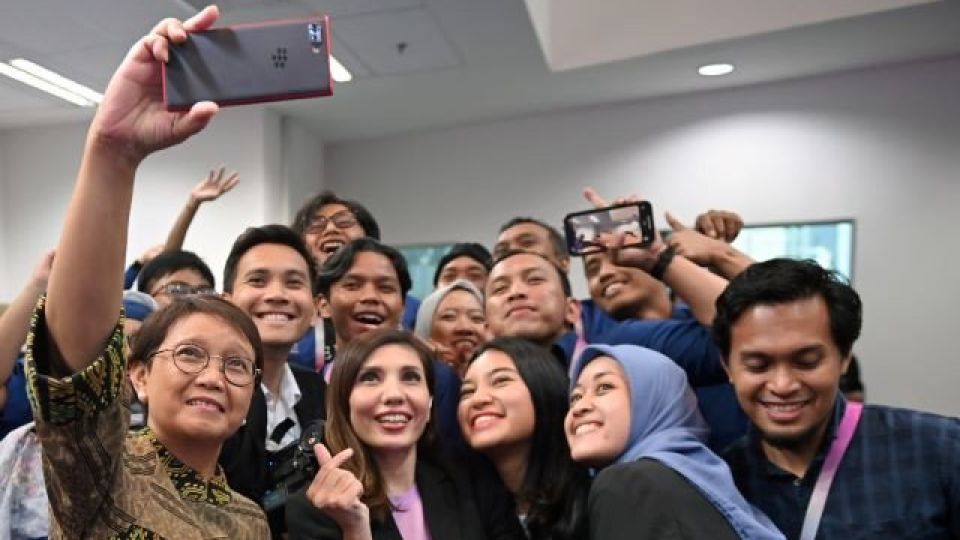August 3, 2023
JAKARTA – The scene is the great lobby of the Shangri-La Hotel in Jakarta. A lady in a nice batik blouse and big black glasses walks through the gallery to lead a series of serious roundtable meetings among a group of men.
There is also a short speech on the importance of ASEAN in dealing with many challenges. In between those meetings, quick selfies and laughter create a warm and friendly atmosphere.
That is the sort of short Instagram video shared by the Foreign Minister Retno LP Marsudi on her personal Instagram account @retno_marsudi nearly every day during the ASEAN Ministers Summit and related meetings last month.
Like Retno, Vivian Balakrishnan, the Singaporean foreign minister, also regularly uploaded videos and pictures of his activities during the summit. These pictures were usually accompanied by a long caption explaining what the meeting had concluded, the important commitments that had been made, and of course, much appreciation for how the meeting was productive and went well.
We would never have imagined these kinds of social media interactions with ASEAN ministers happening 10 years ago. ASEAN meetings and, in fact, many international conferences were often considered long and boring and only of concern to the elite, either government officials or politicians. Certainly, not much of interest to the public.
But today, with the skyrocketing number of social media users, diplomats and government officials are starting to rely on social media platforms to reach a broader audience to promote what they have done and why such achievements are relevant to the general public. Furthermore, the postings demystify what happens around the table of international negotiations. A few years back people could not imagine what really happens inside these negotiations. They simply counted on television channels, which normally aired short footage and news.
Indeed, in the past few years, social media has become an integrated part of the daily life of foreign policy and seems to be an effective way of introducing and communicating with the public at large. Retno, for instance, now has around 506,000 followers on Instagram, while Vivian has 82,000. These are certainly huge numbers and most of the followers appear to be young.
Based on the recent report “Understanding How Young People See ASEAN” published by the ASEAN Secretariat, most of the youth in Southeast Asia learn about ASEAN through the internet and social media rather than the national school system or media.
Indeed, currently, there are 213 million young people in ASEAN countries aged between 15 and 34 years old. This constitutes the largest-ever cohort of ASEAN youth. It is only natural for policymakers to raise youth awareness about what is currently happening in their region and the challenges the region is facing.
However, one of the toughest hurdles facing ASEAN is that not all the region’s young citizens feel they are part of ASEAN, let alone part of the solutions to the region’s problems. This challenge must be tackled under the aegis of the ASEAN socio-cultural pillar.
With the huge number of youth and social media users in Southeast Asia, it is important for policymakers to share the results of important meetings on their social media accounts. Some current issues ASEAN is facing might not be of interest to youth today. However, they might not realize how important they are for them and the region’s future.
For instance, the crisis in Myanmar is crucial as it will define how the region moves forward. Awareness of the Myanmar conundrum will encourage ASEAN youth to engage and communicate with their peers in Myanmar to learn how they can help them get through their plight.
The South China Sea dispute is another important issue for youth to be aware of, because the future security and peace of the region is at stake. Moreover, the conflict is less likely to be solved in the current generation and most likely to be passed through to the next generations.
Assuming the rotating chair of ASEAN, Indonesia has already tried to promote the regional grouping as a valuable asset for ASEAN people. Public participation in solving ASEAN problems will make the bloc matter to all.
Engaging more public awareness of ASEAN issues is important. There are many ways to involve ASEAN people in the efforts to address the challenges and problems ASEAN is facing, and social media seems to be one of the most effective ways.
It is important for ASEAN policymakers to uphold a more genuine interaction with the public and especially youth on social media. Social media is an effective tool not only to familiarize foreign policies and what has been achieved, but more importantly to listen to and tap into aspirations, complaints and grievances of the people, particularly youth.
***
The writer is a PhD scholar at the College of Asia and the Pacific, Australian National University (ANU) and a lecturer in international law at the University of Indonesia.


